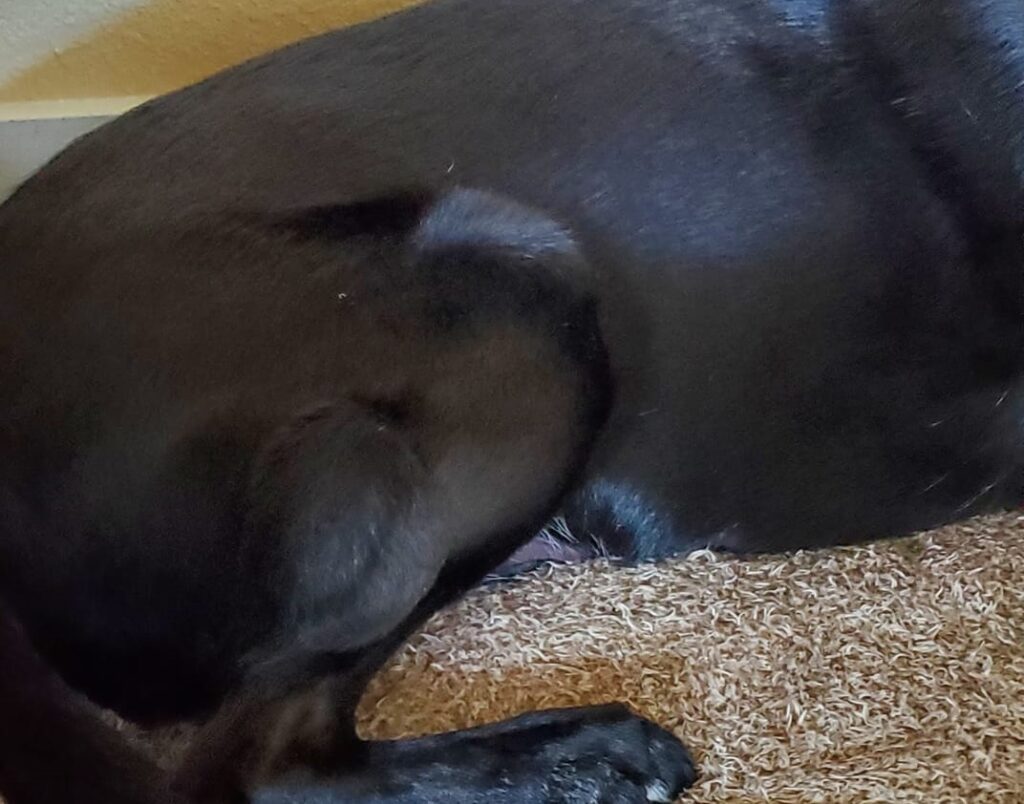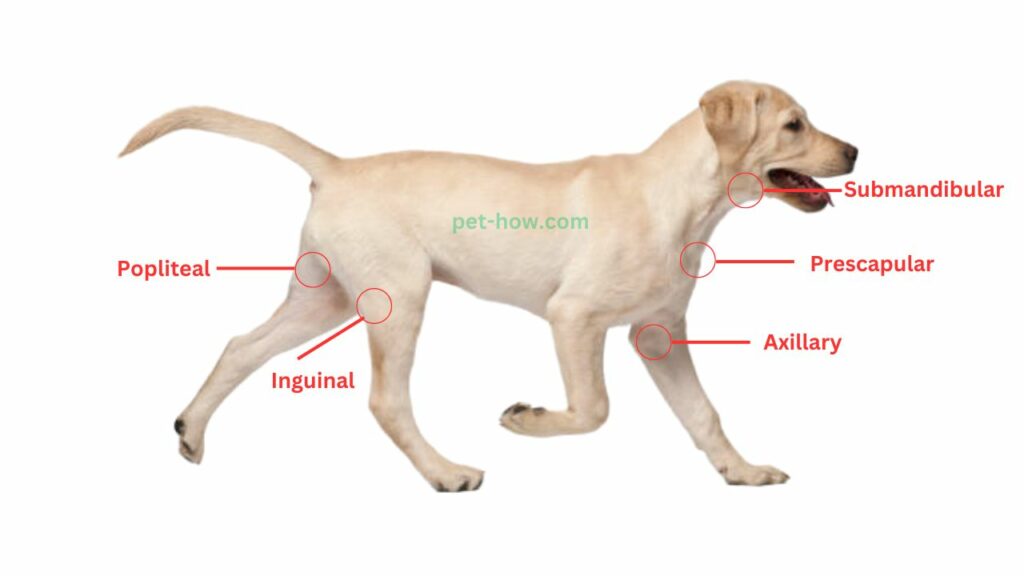This comprehensive guide is designed to help dog owners better understand the critical role of popliteal lymph nodes in their pet’s health.
We’ll delve into the causes behind the enlargement of these nodes, the symptoms to watch out for, and the treatment options available.
Our aim is to equip you with the knowledge to ensure your furry friend stays healthy and happy.
So, let’s dive right in!
- Key Takeaway
- What Are Popliteal Lymph Nodes In Dogs?
- Where Are The Popliteal Lymph Nodes Enlargement In Dogs Located
- What Causes Popliteal Lymph Nodes Enlargement In Dogs
- Symptoms of Popliteal Lymph Nodes Enlargement In Dogs
- Treatment of Popliteal Lymph Nodes Enlargement In Dogs
- Are Popliteal Lymph Nodes Enlargement In Dogs Palpable?
- FAQs
- Q: What can cause swollen lymph nodes in dogs?
- Q: How can I diagnose swollen lymph nodes in my dog?
- Q: What are the treatment options for swollen lymph nodes in dogs?
- Q: Can swollen lymph nodes in dogs be a sign of lymphoma?
- Q: Where are the popliteal lymph nodes located in dogs?
- Q: What are the possible causes of swollen lymph nodes in dogs?
- Q: What is the prognosis for dogs with swollen lymph nodes?
- Q: Can other medical conditions have similar symptoms as swollen lymph nodes in dogs?
- Q: How can a vet palpate a dog’s lymph nodes?
- In Conclusion
Key Takeaway
- Popliteal lymph nodes in dogs are an important part of the immune system, located at the back of the knee area on the back legs, which play a significant role in the body’s defense against infections and diseases.
- The enlargement of popliteal lymph nodes in dogs, indicating a possible infection or disease, is located at the back of the knee area on the back legs.
What Are Popliteal Lymph Nodes In Dogs?

Popliteal lymph nodes are a crucial part of a dog’s immune system, located at the back of the stifle (i.e., the knee area on the back legs).
They play a significant role in the body’s defense against infections and diseases. In a healthy dog, the only palpable lymph nodes are usually the submandibular and popliteal ones.
The popliteal lymph form part of a network of lymph nodes throughout the body that help to filter out foreign materials and fight infections.
These particular lymph nodes are most commonly used when diagnosing conditions associated with the hind legs or lower urinary tract.
See also: Can Dogs Live Without Lymph Nodes?
Where Are The Popliteal Lymph Nodes Located In Dogs Located

Popliteal lymph nodes in dogs are located at the back of the stifle joint, which is the knee area on the back legs.
They lie in the caudal aspect of the stifle joint between the M. biceps femoris and M. semitendinosus muscles.
What Causes Popliteal Lymph Nodes Enlargement In Dogs
- Infections: Bacterial, viral, or fungal infections can lead to swelling in the lymph nodes as the body tries to fight off the invaders.
- Parasites: Parasitic infections, such as those caused by ticks or mites, can also cause lymph node enlargement.
- Autoimmune diseases
- Cancer: In some cases, cancer, such as lymphoma or metastatic cancer (cancer that has spread from another part of the body), can cause lymph node swelling.
- Allergies: Some allergic reactions can cause inflammation and enlargement of the lymph nodes.
- Injury or trauma: Physical damage to the area around the lymph node can result in swelling.
- Certain medications or vaccines: Some drugs or vaccines can cause temporary swelling of the lymph nodes.
See also: Can Dog Lymph Nodes Be Removed?
Symptoms of Popliteal Lymph Nodes Enlargement In Dogs
- Swelling or lump in the area of the popliteal lymph nodes (back of the knee on the hind legs)
- Pain or discomfort in the hind legs
- Difficulty or changes in walking or running
- Lethargy or decreased activity levels
- Loss of appetite
- Unexplained weight loss
- Fever
- Changes in behavior such as increased aggression due to pain
Treatment of Popliteal Lymph Nodes Enlargement In Dogs
Treatment of popliteal lymph nodes enlargement in dogs includes:
- Antibiotics and Antifungals: If a bacterial or fungal infection is causing lymph node enlargement, veterinarians typically prescribe antibiotics or antifungals to treat the infection.
- Anti-inflammatories and Steroids: These medications can be used to reduce inflammation and swelling in the lymph nodes.
- Surgery: In some cases, particularly where cancer is involved, surgery may be necessary to remove the affected lymph nodes.
- Chemotherapy or Radiotherapy: These treatments may be recommended if the lymph node swelling is due to certain types of cancer, such as lymphoma.
- Anti-parasitics: If a parasitic infection is the cause of the swelling, anti-parasitic medication will be prescribed.
See also: How To Check a Dog’s Lymph Nodes
Are Popliteal Lymph Nodes Enlargement In Dogs Palpable?
Yes, the enlargement of popliteal lymph nodes in dogs is palpable. In a healthy dog, the only palpable lymph nodes are typically the submandibular and popliteal ones.
If these nodes become enlarged due to conditions such as infections, autoimmune diseases, or cancer, they can usually be detected through a physical examination.
This enlargement can be felt as a swelling or lump in the area of the popliteal lymph nodes, located at the back of the knee on the hind legs.
In large dogs, the popliteal lymph node can reach a length of 5.0 cm, a width of 3.4 cm, and a thickness of 1.4 cm.
However, it’s important to note that the size of the lymph nodes can vary depending on the breed and size of the dog.
See also: 9 Causes Of Swollen Lymph Nodes In Dogs
FAQs
Q: What can cause swollen lymph nodes in dogs?
A: Swollen lymph nodes in dogs, also known as lymphadenopathy, can be caused by various factors including infections, inflammation, cancer, or immune system disorders.
Q: How can I diagnose swollen lymph nodes in my dog?
A: If you notice a lump or enlargement in your dog’s lymph nodes, consult with a veterinarian. They can perform a physical examination and recommend further diagnostic tests such as blood work, imaging, or a biopsy to determine the underlying cause.
Q: What are the treatment options for swollen lymph nodes in dogs?
A: The treatment for swollen lymph nodes in dogs depends on the underlying cause. It may involve antibiotic therapy for infections, anti-inflammatory medications for inflammation, chemotherapy for cancer, or targeted therapy for immune system disorders.
Q: Can swollen lymph nodes in dogs be a sign of lymphoma?
A: Yes, swollen lymph nodes in dogs can be a symptom of lymphoma. It is a type of cancer that affects the lymphatic system. However, not all cases of swollen lymph nodes are indicative of lymphoma. Further diagnostic tests are required to confirm the diagnosis.
Q: What are the possible causes of swollen lymph nodes in dogs?
A: Swollen lymph nodes in dogs can be caused by infections such as bacterial or viral infections, inflammatory conditions, immune system disorders, or cancerous conditions like lymphoma.
Q: What is the prognosis for dogs with swollen lymph nodes?
A: The prognosis for dogs with swollen lymph nodes depends on the underlying cause. In some cases, the swelling may resolve with appropriate treatment. In other cases, the prognosis may be more serious if the cause is cancerous or severe disease.
Q: Can other medical conditions have similar symptoms as swollen lymph nodes in dogs?
A: Yes, other medical conditions such as abscesses, cysts, or tumors can also present as lumps or enlargements that may resemble swollen lymph nodes in dogs. Proper diagnosis by a veterinarian is crucial to determine the exact cause.
Q: How can a vet palpate a dog’s lymph nodes?
A: To palpate a dog’s lymph nodes, a vet will use their fingers to gently feel for any enlargement, lumps, or abnormalities in the lymph node areas such as the neck, armpit, groin, or behind the knee. This allows them to assess the size, texture, and consistency of the lymph nodes.
In Conclusion
Popliteal lymph nodes in dogs, located near the hind legs, play a crucial role in their overall health.
A myriad of factors can contribute to the enlargement of the popliteal lymph nodes in dogs. These include bacterial or fungal infections, tick-borne diseases, and various forms of cancer.
Symptoms often manifest as noticeable swelling in one or multiple lymph nodes.


Leave a Reply